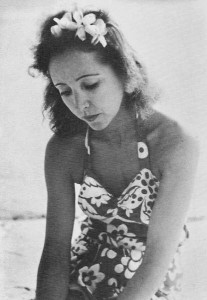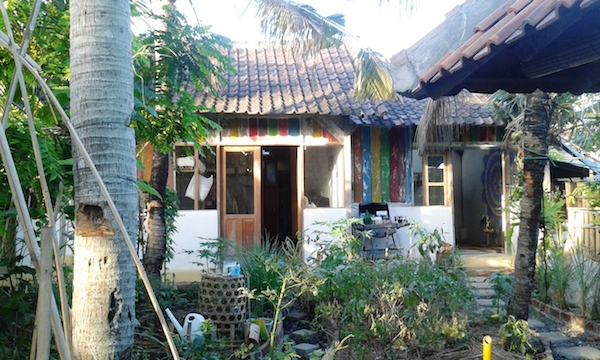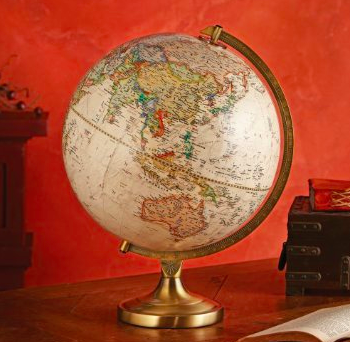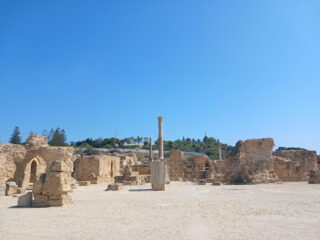By Tess Joyce
“The colors, the perfumes, the dances, the music of Bali stay with you because they all penetrate deeper into our psychic life; it is one of the Bardo states we are allowed to live, a privilege, a voyage through a karma of joy not granted to Western man, a joy which comes from shared work and symbolic oneness with nature, with religion and with other human beings. We could not create this, but it was given to us as an offering, perhaps with the message: Do not corrupt it.” Spirit of Bali (1975)
 One of the first female writers of erotica, Anaïs Nin is perhaps most famous for her soul-penetrating diaries, her bohemian love affair with writer Henry Miller and an incestuous relationship with her father at the advice of her psychologist. She was also heavily involved in the psychoanalyst scene, and was interested in integrating and harmonising the self through the process of writing. Therefore it is no surprise that she idealised the idyllic island of Bali—a quiet refuge in which man lived in harmony with his universe.
One of the first female writers of erotica, Anaïs Nin is perhaps most famous for her soul-penetrating diaries, her bohemian love affair with writer Henry Miller and an incestuous relationship with her father at the advice of her psychologist. She was also heavily involved in the psychoanalyst scene, and was interested in integrating and harmonising the self through the process of writing. Therefore it is no surprise that she idealised the idyllic island of Bali—a quiet refuge in which man lived in harmony with his universe.
But Anaïs visited Bali in the 1970s. Now, almost 40 years have taken their toll on this popular tourist destination. Bali has faced many difficulties in recent years, including over-development, plastic waste, rice paddy land conversion, water depletion, unsustainable tourism, binge-drinking and violence. Recent figures show that one Australian dies every nine days in Bali. Would Anaïs have found peace on this modern-day island? How is harmony being restored?
It’s a complex subject, and artists, activists and environmentalists are trying to come up with some practical solutions. I recently met Balinese artist Made Bayak Muliana at Ubud Writers and Readers Festival this October and saw his art exhibition, Plasticology. The title is a fusion of the words plastic and ecology, and his art sought to highlight one of the major problems that Bali is currently facing: plastic waste. Clogging up drainage systems and drifting into rivers and the sea, plastic is ubiquitous and the waste collection facilities are far from adequate—even the locals are beginning to swap their traditional banana leaves and petals (gifted as daily offerings) with plastic plates and other modern items.
Even as I walked down Ubud Main Street, I was concerned to see single-use plastic cups scattered across the road in large numbers. Big coaches tried to squeeze down small lanes, bringing tourists to visit Ubud’s sacred temples. Ubud used to be the quiet, cultural hub of Bali—far away from the hectic tourist destinations in the South, such as Kuta beach.
Tourism has had a big impact on Bali but it would be counter-productive to try and simplify this extremely complicated situation. As the Ubud Writers and Readers Festival finished, I was amazed to see its founder, Janet DeNeefe, comment on the impacts of tourism on Ubud and Bali. She remarked that the island was still wonderful. This word surprised me after all of the waste I had seen, but I felt that there must be some truth in it— I decided to withhold judgement until I had explored the island’s philosophies and places.
When Balinese expert Fred Eiseman first arrived in Bali in 1961, he admitted in his book Bali: Sekala & Niskala that there were no tourist buses and no jet-planes. Yet far more importantly, he wrote this argument against oversimplification: “Anyone who purports to write about ‘the way it is in Bali’ is either ignorant or a liar. One would think that local variations in culture on such a tiny island would be insignificant. That is not the case. One of the first things a careful investigator learns is the principle of desa kala patra: that whatever one learns in Bali is largely determined by where he is, when he is there, and the circumstances under which the learning occurs.”
So for the purposes of this article I will try and not be too black and white about things and will remember the principle of desa kala patra. To understand more about the ethos of harmony in Bali it is perhaps best to start with the notion of black and white—or good versus evil and other such dualistic conceptions. A Balinese person will devote themselves to the pursuit of a balance between the opposing (yet co-dependent) forces of good and evil. “Harmony is restored when karma (our actions) align with the dharma (order)—adharma is therefore disorder and arises when our actions are destructive,” explained Eiseman.
After soul-searching for many years through her experimentation with sexuality and her writings, Anaïs finally found some peace after discovering the dharma of Bali. In Maryanne Raphael’s biography, Anaïs Nin: The Voyage Within, she writes, “Anaïs had never before been so excited about visiting a country. She knew the Balinese had a high form of life where religion, art and nature harmonized. Self and society were as one.” Later, Raphael included a delightful quote by Nin and her pursuit of harmonizing the self: “Deep writing comes from an in-depth exploration of the unconscious. Writing is the ultimate instrument for exploring new forms of consciousness. It is a means to ecstasy and a way to link dreams to actions. I teach writing as a way to reintegrate ourselves when experience shatters us.”
Perhaps one of Anaïs Nin’s greatest fears was abandonment (her father, the composer Joaquín Nin left the family when Anaïs was eleven years old. She was also keenly aware of the impermanency of life. In 1923, she was married (at the young age of 20) to Hugh Guiler (also known as Ian Hugo) and after moving to Paris, she was destined to live a quiet life as a humble housewife. Instead, she became one of the first women to write erotic fiction, engaged in various love-affairs, and broke the law by marrying twice. In 1955 she married actor Rupert Pole (who was sixteen years younger than Anaïs) in Arizona, the news of which was only revealed to Guiler after Nin’s death.
In order to keep track of her different identities, biographer Deidre Bair once explained, “She had to create something she called the ‘lie box.’” Reality at that time, was far harder to face. “I could not bear the passing of things. All flowing, all passing, all movement choked me with anguish,” she once wrote in House of Incest. It is interesting to note that as Henry Miller wrote Tropic of Cancer, he was enjoying an affair with the married Anaïs. In contrast to Nin, Miller embraced the impermanency of the universe, and in her journal, Henry and June, she reverently writes about his rhythm. “Yes, I said to myself, I too love everything that flows: rivers, sewers, lava, semen, blood, bile, words, sentences,” wrote Miller.
In 1955, Anaïs first took LSD under the guidance of Aldous Huxley and wrote a beautifully evocative description of her visions and subconscious landscape which included images of Javanese temples, Balinese music, symbolic dance gestures before finally finishing with the conclusion, “Ah, I cannot capture the secret of life with WORDS.” She was beginning to reveal what her soul desired deep down—for Anaïs, utopia was a state of mind in which the artist had access to the world of dreams. Perhaps this is why she fell in love with the mysticism and art of Bali. In her final journal (volume 7 of her diaries) she finished with a reflection on her trip to this island, complete with magical descriptions of sacred cremations, opulent gardens, temple dances, Wayang shadow puppets, natural-material bungalows used as hotels, the haunting music, and the sophisticated and gentle ways of the Balinese people.
Despite suffering from cancer, Anaïs managed to visit the country after being offered a free trip by a tourism agent Charlotte Hyde, who covered the costs in exchange for a few articles. Maryanne Raphael’s biography depicts the scene wonderfully, “Anaïs sat looking out at the sea and wondered, “Will I ever come back here? Do I really have to leave Bali where inner and outer beauty are one? Why do I already fear the loss of those I love?””
Yet Bali is experiencing a loss of culture, art and connection with nature – a perfect metaphor for this change is the demise of the sacred art-form gambuh. As Bali’s oldest performance art, this ritual theatre dates back to the Majapahit era and has survived for over 500 years. I was recently lucky enough to watch a performance in the village of Batuan, near Ubud and met the gambuh performer I Wayan Bawa, who has toured internationally. It was Saraswati Day (the goddess of knowledge) and a special ceremony of dance and wayang had been organized at the village temple, yet I was surprised to notice that only a few Western tourists stayed to watch the gambuh performance with their keen-eyed SLR cameras and only a handful of locals had watched the wayang, preferring instead to catch the shorter shows. Bawa admitted that he had concerns over gambuh’s survival, partially because of the intense training required in order to master the ancient Kawi language, not to mention the technical music played with long flutes. The art form’s duration has also proved unappealing to the modern-day attention span.
Yet I was mesmerised by the delicate performance in which the dancers composed themselves like flamingos and stared meditatively; their extravagant golden costumes were reminiscent of classic Hindu-Javanese court culture. Although cultural traditions such as this are becoming endangered, I think I understand what Janet DeNeefe meant at the Ubud Writer’s and Reader’s Festival when she reiterated the word, wonderful when describing modern-day Bali. Sacred places can still be found—if you look closely you will find people training, meditating, healing and performing sacred dances, yet one thing has changed—the spectrum of black and white has widened as more factors enter the equation.

Under the analysis of Otto Rank, Anaïs began to learn more about psychology and gained a stronger understanding of the mind, embracing all facets of herself. She later came to the conclusion that all evil stemmed from “the lack of knowledge of our unconscious self.” If this is true, then perhaps the changes that we are witnessing in Bali and across the world are in some way a reflection of the inner psyche, of a world too distracted to take things slow and to peer deep within, as psychologists, philosophers and spiritual thinkers have done over the centuries.
Yet some youngsters in Bali are unwilling to be distracted by the waves of fast-paced modernity and are actively campaigning to promote sustainable, healthy food production and to protect the island’s natural resources. I recently met the Permablitz Bali group in Canggu and joined them as they planted gardens for friends and members of the group. Taking things slow, they enjoyed turning their gardening into a social event by bringing along home-cooked food and jamming in the evening with guitars and djembes.
The Permablitz movement began in 2006 when permaculture designer Dan Palmer began growing organic food in urban environments of Australia. Since then it has spread to Hawaii, Barcelona, America, Jogjakarta, and now Bali. Based on the science of Permaculture (a compound of the words “permanent” and “agriculture”), which was developed by Bill Mollison in the 1970s, it aims to develop functional and practical systems that mimic the patterns of nature—all waste, nutrients and energy are recycled back into the system.
The group are keen to think up solutions to Bali’s problems including its shrinking water-tables and dried-up aquifers by encouraging water storage and collection. At a recent awareness event they recycled plastic waste with local children, creating artwork, and now the team are focusing on sustainable tourism. I recently visited their hostel, Farmer’s Yard, which aims to put “an end to careless tourism,” by encouraging guests to help in the permaculture garden, compost their waste, cook local food, and interact with the Balinese neighbours.
It seems that despite the problems, solutions can always be found if we observe a little closer. What would nature do? How can visitors and tourists align their karma (actions) with dharma and restore harmony again in Bali? It always comes down to the individual and the choices we make. Will we support plastic consumption and unsustainably developed hotels? Or will we support the organic, environmentally-conscious movements which are rapidly spreading across Bali? Will each of us remember Anaïs Nin’s message in time?
Tess Joyce is a poet, nomad, environmentalist and writer from the UK who has lived in Indonesia for the past four years. Her articles about culture and the environment have appeared on Indonesia Expat, GoNOMAD and other online magazines.
Main page image by Ilse Reijs and Jan-Noud Hutten. Other images by Tess Joyce.










